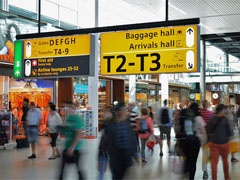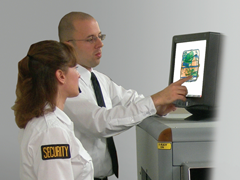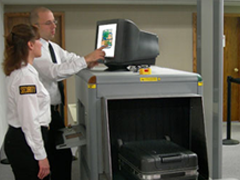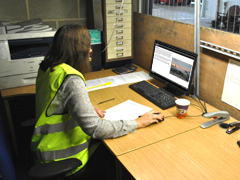I recently attended an aviation security conference in Dublin, Ireland. The speaker panels were well organized and the topics were very relevant in view of the many threats commercial aviation must mitigate. However, there was a common theme flowing through the conference that stuck with me perpetrated by the International Air Transport Association (IATA) who sponsored the event. That theme is simply this – IATA is all about the passenger experience.

Michael Rooksby
Read some of his blog posts below:
My Passenger Experience: A Personal View
Posted by Michael Rooksby on Monday, December 14, 2015 at 1:30 PM
Topics: General, Transportation
How to Make the Summer Travel Season Better for Security Screeners
Posted by Michael Rooksby on Tuesday, April 28, 2015 at 3:15 PM
Every year as we approach summer, I see news articles, social media postings, and even talk radio exasperating about how bad the busy travel season will be. The focus is generally on the traveler experience. True, already busy and cramped airports will become even more busy and cramped during the high travel season. This makes the travel experience more stressful and most certainly less fun.
The security checkpoint is usually one of the most congested places in an airport. Thousands of passengers are trying to get from landside to airside as quickly and easily as possible. The passengers are generally a mix of seasoned travelers and seasonal travelers. The latter is usually excited to be getting underway while the prior is just trying to get through the system.
Security screeners play a huge role in helping both groups get through screening as safely and efficiently as possible. Who better to ask about little things passengers can do to make the screening process and the job of a security screener a little easier this summer season. So that’s what we did.
Topics: Aviation Security, Trends
Shifting from 2D to 3D X-ray Interpretation
Posted by Michael Rooksby on Wednesday, April 22, 2015 at 11:30 AM
In the aviation security world, conventional X-ray systems are still the dominant technology used to screen baggage and cargo. The technology is proven, stable, and holds up well to the operational demands of an airport. However, one of the biggest challenges for screeners is trying to interpret what’s inside a passenger’s baggage using a ‘flat’ or two-dimensional (2D) image.
As three-dimensional (3D) X-ray systems continue to improve, we can expect more of them to be widely deployed at airports. Meanwhile, X-ray screeners will have to learn how to shift from 2D to 3D X-ray interpretation.
Topics: Aviation Security, Trends, Training & Development
The Dress Color & Why it Might Matter in X-ray Image Interpretation
Posted by Michael Rooksby on Tuesday, March 17, 2015 at 3:45 PM
The Dress – over 73 million page views on the original Tumblr post and 480,000+ notes after just 2.5 days. Why is there all this fuss about the color of that dress? As reported by almost every social media outlet on the planet, some see white and gold and others see blue and black. It just shows us how funny the human brain can be. Somehow the picture of that dress destroys the brain’s ability to discern between colors.
I saw one post that said, “It is a collision of color, illumination, and reflection.” I thought it was very interesting that “illumination” was used to describe this phenomenon. What I found, doing a little old fashioned research, is that it’s very easy (especially in photographs) to change the perceived color of an object by changing the illumination.
Topics: Trends, Current Events
Threat Information Sharing in the Global Aviation Industry
Posted by Michael Rooksby on Tuesday, February 17, 2015 at 2:00 PM
Everyday security screeners at airports all over the world have a very difficult job to do. Security screeners often lack up-to-date threat information as they screen hundreds of passenger bags each day. They rely on any current information provided by local authorities and their own historical knowledge to make the best decisions possible.
Talking with security screeners from a wide variety of international airports about this issue, one common theme prevails. There is no formal mechanism for sharing such threat information. In most cases, the best sources for getting information about new or emerging security threats are via the media or when items are found at the checkpoint where the security screener works.
Topics: Security Training, Aviation Security, Security Threats
X-ray Screener vs. Radiologist: How They Compare
Posted by Michael Rooksby on Wednesday, February 11, 2015 at 12:00 PM
There is often a lot of criticism about how security screeners do their job. The mainstream and social media offer many accounts about how screeners don’t know what they are doing and how they search passenger bags inconsistently from one airport to the next.
Certainly, there is room for improvement for all of us. However, when we look at the characteristics of a security screener and his work environment and compare them to those of a radiologist, we might all decide to give screeners a break.
Here’s an infographic comparing an X-ray screener to a radiologist.
Topics: Security Training, Aviation Security
Aviation Industry Trends, Predictions & Advice for 2015
Posted by Michael Rooksby on Tuesday, January 20, 2015 at 11:00 AM
At the start of every year, experts release trends and predictions for the airline and air cargo industries. As usual, there is a lot of information floating around and it’s sometimes difficult to make sense of it all. This is especially true as we look at regional anomalies that don’t align with broader global trends.
Having said all that, I’ve conducted a little research, gathered the most interesting information, and assembled them here just for you. Let’s take a look at current aviation industry trends, predictions for 2015, and advice from the experts.
Topics: Security Training, Aviation Security, Trends, Transportation
Operational Constraints Meet Mandatory Requirements in Aviation Security
Posted by Michael Rooksby on Thursday, January 8, 2015 at 10:30 AM
One of the most frustrating things an Operational Manager must do is pull productive resources off the line for mandatory training events. In the highly regulated environment of aviation security, this happens all the time. It doesn’t matter if your aviation security training program was made to comply with the US TSA, UK DfT, EU, or any other government entities.
Anytime there’s a security incident, operational procedures at the local, regional, or international level are bound to change. These changes need to be communicated to employees quickly, effectively, and in a standardized way. The repetitive cycle of pulling off resources for training and recertification continues, fueling the conflict between mandatory security requirements and operational constraints.
Although there may be no end in sight for these disruptions, there are ways to mitigate their influence on your operational performance. Handle these stresses by incorporating these four key elements into your regulatory training program.
Topics: Security Training, Aviation Security








